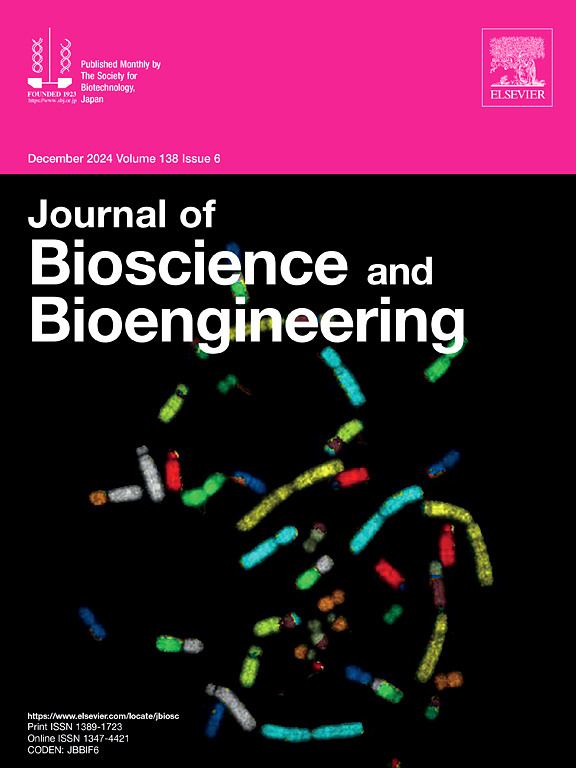Protective role of hematin in alcohol oxidase-mediated glycerol oxidation: A kinetic modeling approach
IF 2.9
4区 生物学
Q3 BIOTECHNOLOGY & APPLIED MICROBIOLOGY
引用次数: 0
Abstract
Mathematical modeling of complex multi-catalytic reaction pathways is a powerful tool not only for determining optimal operational conditions but also for gaining insights into the kinetic behavior of efficient yet product-sensitive enzymes. This approach was applied to the biooxidation of glycerol using oxidases, aided by hematin, a natural mimic of heme peroxidases and catalases, which acts as a scavenger for enzymatically produced H2O2. The bi-catalytic reaction system was coupled with the formation of a colored imine product from phenol and 4-aminoantipyrine, enabling spectrophotometric monitoring of reaction kinetics. Alcohol oxidase (AOX) from Komagataella pastoris (formerly Pichia pastoris) was submitted to this strategy to overcome some kinetic drawbacks previously observed with galactose oxidase (GAO) from Dactylium dendroides. Although both enzymes exhibited comparable oxidation yields, computer-aided kinetic analyses revealed significant differences in efficiency and sensitivity to H2O2. AOX demonstrated two orders of magnitude greater efficiency and a similarly higher affinity for glycerol. However, AOX showed a stronger tendency to bind H2O2 compared to hematin or GAO, as suggested by the ratio of the inhibition constant (kinh) to the activation constant (k1) for hematin. The kinetic model was also used to simulate optimal conditions for enhancing the stability of AOX and hematin. Reducing glycerol concentration or increasing hematin concentration improved AOX stability, while the addition of phenol helped preserve hematin. The predicted stabilities turn the AOX/hematin/phenol system promising for biosensing or analytical applications.

血红素在醇氧化酶介导的甘油氧化中的保护作用:动力学建模方法。
复杂的多催化反应途径的数学建模不仅是确定最佳操作条件的有力工具,而且还有助于深入了解高效且对产物敏感的酶的动力学行为。这种方法被应用于氧化酶对甘油的生物氧化,在血红素的辅助下,血红素是血红素过氧化物酶和过氧化氢酶的天然模拟物,它作为酶促产生的H2O2的清除剂。双催化反应体系与苯酚和4-氨基安替比林形成有色亚胺产物相结合,使反应动力学的分光光度监测成为可能。来源于毕赤酵母(Pichia pastoris)的酒精氧化酶(AOX)被用于该策略,以克服先前来自Dactylium dendroides的半乳糖氧化酶(GAO)所观察到的一些动力学缺陷。尽管这两种酶的氧化率相当,但计算机辅助动力学分析显示,它们的效率和对H2O2的敏感性存在显著差异。AOX的效率提高了两个数量级,对甘油的亲和力也同样高。然而,AOX对H2O2的抑制常数(kinh)与激活常数(k1)的比值表明,AOX对H2O2的结合比血凝素或GAO更强。该动力学模型还用于模拟提高AOX和血凝素稳定性的最佳条件。降低甘油浓度或增加血素浓度可提高AOX的稳定性,而苯酚的加入有助于保存血素。预测的稳定性使AOX/血红素/酚系统有望用于生物传感或分析应用。
本文章由计算机程序翻译,如有差异,请以英文原文为准。
求助全文
约1分钟内获得全文
求助全文
来源期刊

Journal of bioscience and bioengineering
生物-生物工程与应用微生物
CiteScore
5.90
自引率
3.60%
发文量
144
审稿时长
51 days
期刊介绍:
The Journal of Bioscience and Bioengineering is a research journal publishing original full-length research papers, reviews, and Letters to the Editor. The Journal is devoted to the advancement and dissemination of knowledge concerning fermentation technology, biochemical engineering, food technology and microbiology.
 求助内容:
求助内容: 应助结果提醒方式:
应助结果提醒方式:


